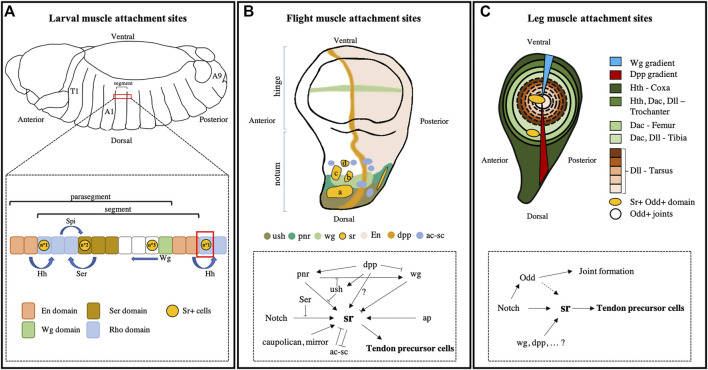FIGURE 1.
Signaling regulators of tendon cell specification. (A) During embryogenesis, the Drosophila embryo is divided into 14 parasegments (PS) and then further divided into 15 segments. Each PS is delimited by the Engrailed (en) and Wg domains that secrete Hh and Wg signaling molecules, respectively. These signals delimit segments that comprise 12 rows of cells and can be further subdivided into different domains of expression (Rho+, Ser+, Wg+, and En+ domains). In the three rows of each segment, sr expression is induced through the differential combination of patterning signals. sr expression in row n°1 is induced by Hh signaling in a Rho+ domain. In row n°2, sr expression is under the control of Spi/EGFR signaling in a Ser+ domain. Lastly, a third Sr+ row is defined by the Wg signaling pathway. (B) In the Drosophila wing imaginal discs, sr is expressed in five clusters located in the notum: Three in the anterior region (a–c) that give rise to the anterior attachment sites of the so-called Dorso-Longitudinal flight Muscles (DLM), one in the posterior region at the origin of the posterior attachment sites of these same DLM and one (d) that corresponds to the future attachment site of the TDT or jump muscle (Ghazi et al., 2003). The initiation of sr expression is mediated by several regulatory interactions and is dependent on local signaling factors that ensure the segmental subdivision of disc territories. The expression pattern of these genes shows that sr expression is regulated differently in each cluster. Dpp demarcates the antero-posterior axis and positively controls sr expression through pnr and by limiting Wg activity. N is required for the induction of sr expression in all clusters, however its activity is antagonized by its ligand Ser. At high levels, Wg suppresses sr expression, whereas a moderate level of Wg initiates sr expression. Apterous (ap) and Iroquois family gene products (caupolican and mirror) positively regulate sr expression. Sr and ac-sc exhibit mutually antagonistic activities. Arrows represent gene activation and arrow bars indicate repression (adapted from Ghazi et al., 2003). (C) In leg imaginal discs, Wg and Dpp morphogen diffusion create a gradient from the ventral to the dorsal region establishing the first pattern of the dorso-ventral axis. Then, this gradient induces the expression of segmental genes (Hth, Dac, and Dll) along the proximo-distal axis. The Notch pathway defines boundaries between the presumptive segments by inducing odd-skipped family gene expression in a ring of epithelial cells. Notch is also required to trigger sr expression in discrete domains along the odd-positive rings. This way, a total of seven Sr-positive clusters are specified (only two are represented here), which give rise to long internal tendons.

